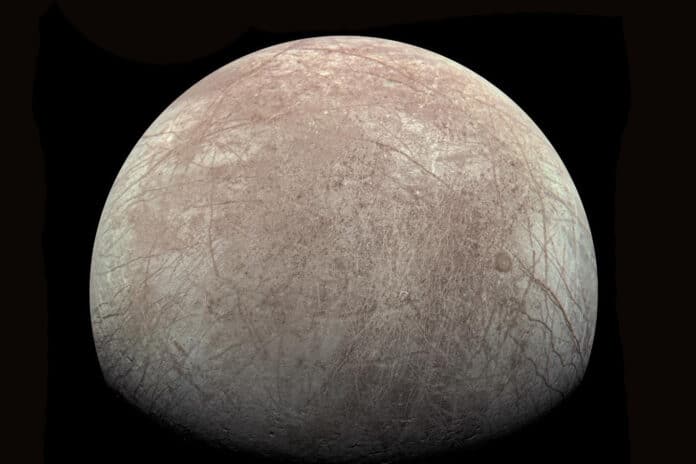The shell of Europa is likely free-floating and rotates at a different rate than the water underneath it and the interior’s rocky surface. Below its icy exterior, Jupiter’s moon Europa has a vast ocean of salty water flowing around its rocky interior.
New computer modeling suggests the water may be pushing the ice shell along, possibly speeding up and slowing down the rotation of the moon’s icy shell over time. The model is the first to show that Europa’s ocean currents could be contributing to the rotation of its icy shell.
Calculating drag—the horizontal force the moon’s ocean puts on the ice above it—was a critical study component. The study suggests that part of the geology observed on Europa’s surface may be explained by the power of the ocean flow and its drag against the ice cover. The frozen shell may develop ridges and cracks due to the ocean’s currents pushing and pulling on it over time.
Hamish Hay, a researcher at the University of Oxford and lead author of the study, said, “Before this, it was known through laboratory experiments and modeling that heating and cooling of Europa’s ocean may drive currents. Now our results highlight a coupling between the ocean and the rotation of the icy shell that was never previously considered.”
It is feasible to estimate how quickly the icy shell rotates using data collected by NASA’s planned Europa Clipper mission. Scientists will be able to evaluate the locations of ice surface features and maybe determine whether the moon’s icy crust has moved over time when they contrast the photographs taken by Europa Clipper with those born in the past by NASA’s Galileo and Voyager missions.
Co-author and Europa Clipper Project Scientist Robert Pappalardo of JPL said, “To me, it was completely unexpected that what happens in the ocean’s circulation could be enough to affect the icy shell. That was a huge surprise. And the idea that the cracks and ridges we see on Europa’s surface could be tied to the circulation of the ocean below – geologists don’t usually think, ‘Maybe it’s the ocean doing that.’”
Scientists used techniques- developed to study earth’s oceans- to make large-scale models of Europa’s ocean on NASA supercomputers. They investigated the subtleties of water circulation, including how heating and cooling affect it.
In the simulations, the circulation started moving vertically. Still, the overall rotation of the moon caused the water to swerve in east-west and west-east currents, which are more horizontal. The researchers concluded that if the winds are swift enough, there may be a sufficient drag on the ice above to speed up or slow down the shell’s rotation speed by incorporating drag in their calculations. The degree of inner warmth, and consequently the ocean’s circulation patterns, may alter over time, possibly causing the frozen shell above to rotate more quickly or more slowly.
Hamish Hay, a researcher at the University of Oxford and lead author of the study published in JGR: Planets, said, “The work could be important in understanding how other ocean worlds’ rotation speeds may have changed over time. And now that we know about the potential coupling of interior oceans with the surfaces of these bodies, we may learn more about their geological histories as well as Europa’s.”
Journal Reference:
- H. C. F. C. Hay, I. Fenty, R. T. Pappalardo, Y. Nakayama. Turbulent Drag at the Ice-Ocean Interface of Europa in Simulations of Rotating Convection: Implications for Nonsynchronous Rotation of the Ice Shell. JGR Planets. DOI: 10.1029/2022JE007648
